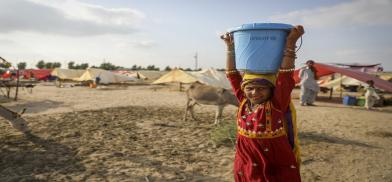Chronic water scarcity in South Asia increasing children’s vulnerability
In 2022, an overwhelming 45 million children lacked access to basic drinking water services in South Asia, according to UNICEF

Water is the elixir of life. Yet the world's most valuable resource is in severe shortage worldwide, especially in South Asia. Water scarcity is defined as the lack of water to meet the demands of a specific population. The low recharge rates cause it, and decades of misuse and poor management aggravate it. Over-extraction of groundwater and contamination of supplies accentuate the crisis. A sufficient amount of safe water is a child's right too and a shortage of it can jeopardize their childhood affecting their well-being and growth leading to malnutrition and causing diseases like diarrhoea.
In South Asia, a major victim of capricious and deleterious climate changes, the situation gets worse for children. A startling 347 million children under 18 are susceptible to high water scarcity in South Asia, the highest number among all regions of the world, according to a new UNICEF analysis. (‘South Asia has the highest number of children exposed to severe water scarcity-UNICEF’, November 13, 2023. Source: https://www.unicef.org/rosa/press-releases/south-asia-has-highest-number-children-exposed-severe-water-scarcity-unicef#:~:text=Poor%20water%20quality%2C%20lack%20of,of%20the%20world's%20renewable%20water)
Climate change compounds water scarcity
Water scarcity is being compounded by climate change which is increasing the vulnerability of children too. UNICEF’s groundbreaking Children’s Climate Risk Index (CCRI) in 2021 provides a deep dive into one dramatic example of the risks of water scarcity and vulnerability. In 2022, an overwhelming 45 million children lacked access to basic drinking water services in South Asia, according to UNICEF. The main reasons for water scarcity in South Asia are poverty and power inequalities. Millions of families in South Asia do not have a dedicated tap water line. In 2018, India had a vision to reach out to 90 per cent of rural households of piped water by 2022. The availability of clean water is sparse. Installation of water infrastructure is a costly affair as its maintenance. The alternative is bottled water which pollutes the environment, increasing plastic use. Besides, the perils of climate change have exacerbated the problem. Every child in South Asia is affected by at least one climate or environmental hazard, shock, or stress. The most vulnerable, rural and poor children, are being affected the hardest. Their childhood is endangered. Furthermore, soaring temperatures and rising sea levels have started contaminating freshwater reserves. Without urgent climate change mitigation, the entire water supply may get disrupted.
According to the International Monetary Fund, Pakistan is in third place for acute water shortage, and this scarcity is significantly affecting the population. Each day, approximately, 1,100 Pakistani children die from diarrhoea and illnesses related to the quality or quantity of water. Because of malnutrition, in Pakistan 30% of children are underweight, more than 50% suffer from stunted growth, and around 9% from emaciation. With 24% of the population living below the poverty line, poverty is one of the main reasons that many people in Pakistan suffer from and this leads to significant risks for the children too. Children in Nepal too have imperilled childhoods due to lack of sufficient water. However, with Water Safety Plans (WSP), the Nepali citizens have been able to mitigate the problem. Maldives too, is a visual reminder of a beleaguered nation due to a shortage of water supply. Drinking water shortage is common with children complaining of skin irritations and infections. In Afghanistan, the affected provinces are Bagdhish, Bamyan, Daykundi, Ghor, Helmand, Kandahar, Jawzjan, Nangarhar, Nimroz, Nuristan, Takhar, Uruzgan; they are of critical priority for nutrition and water. The situation is complicated by the escalating effects of war and displacement.
Adverse effects on children
Compared to adults, children need more water per unit of their body weight. Water scarcity metastasizes the problems of children. Due to a lack of sufficient water to consume or to use many children drop out of school. This has a lifelong impact on their health and education. Water scarcity can also increase the incidence of several diseases. A reduction in the availability of fresh water for drinking and hygiene places children at increased exposure to diseases such as cholera, typhoid, acute respiratory infections, and measles. In extreme cases, all these may lead to lifelong morbidities and death. A child who lacks access to adequate water, sanitation, and hygiene facilities (WASH) is more vulnerable to climate and environmental hazards, shocks, and stresses. In the absence of an uninterrupted supply of water, vital healthcare services can be disrupted.
Water access is basic human right
Providing a safe, clean, and uninterrupted water supply is the basic human right of children and an integral part of critical care services. Water insecurity leads to deprivation and loss of a lifetime of opportunities. Taking miles to travel to fetch water is the biggest handicap crushing the hopes and dreams of children. To be precise safe water equals life.
To combat the problem of vulnerable children grappling to survive water scarcity three-pronged strategy will suffice—to provide access to water closer to homes; ensure a climate-resilient world; and develop sustainable water resource management for future generations.
(The author is an Assistant Professor, at the Department of Political Science, Jangipur College. Kalyani University, West Bengal. Views are personal. She can be reached at koyelbasu1979@gmail.com).
think every one is getting more from this web site, and your views
are good designed for new users.











Post a Comment